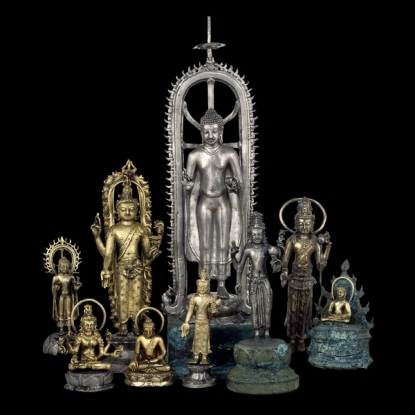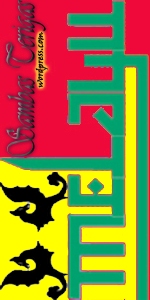The Sambas Treasure / Harta Karun dari SAMBAS
Posted by Wahyudi English on May 28, 2009
Silver Buddha on a bronze lotus base
From Borneo, Indonesia; probably made in Java 8th or 9th century AD

Sculpture from the Sambas Treasure
The right hand of the Buddha is held in the gesture of argument or discussion (vitarkamudra), his left holds his robes. He stands before an aura of light edged with flames. Above his head is a parasol, a reminder of his early life as a prince. This very fine image is solid cast in silver with a small gold inlay in the centre of his forehead (urna), a distinctive mark of the Buddha. Gold inlay is typical of many bronze images made in eastern India. Metal sculptures were carried to the islands of South-east Asia by pilgrims returning from the Buddhist holyland in eastern India. However, the style of this image is local, and it was probably made in Java.
This is one of a large group discovered at Sambas in western Borneo and thus known as the ‘Sambas Treasure’. Until the coming of Islam in the late thirteenth century, much of island South-east Asia professed Buddhism or Hinduism. This sculpture is one of the earliest found in this area of maritime South-east Asia. With this image were found eight other gold and silver images, either the Buddha or bodhisattvas, along with a unique bronze incense burner in the shape of a house. Sambas was important as an ancient source of gold in South-east Asia. The production of so many images in such prestigious materials as gold and silver suggest that they were made for a very wealthy patron.
N. Tarling (ed.), The Cambridge history of South (Cambridge University Press, 1992)
R.E. Fisher, Buddhist art and architecture (London, Thames & Hudson, 1993)
Source : British Museum dot org
 This blog is for my own self-expression for my homesickness.
It's been long time I left my hometown, my culture, and my big family there.
This is my starting point to know and to learn again our culture, our language and our history.
I am trying to be aware again of our great civilization for the sake of the glory of Sambas.
This blog is for my own self-expression for my homesickness.
It's been long time I left my hometown, my culture, and my big family there.
This is my starting point to know and to learn again our culture, our language and our history.
I am trying to be aware again of our great civilization for the sake of the glory of Sambas.

Leave a comment